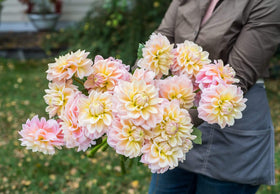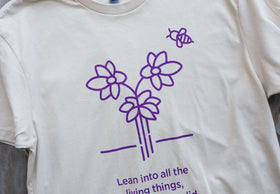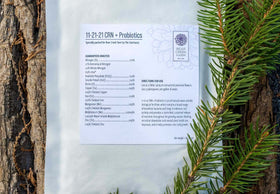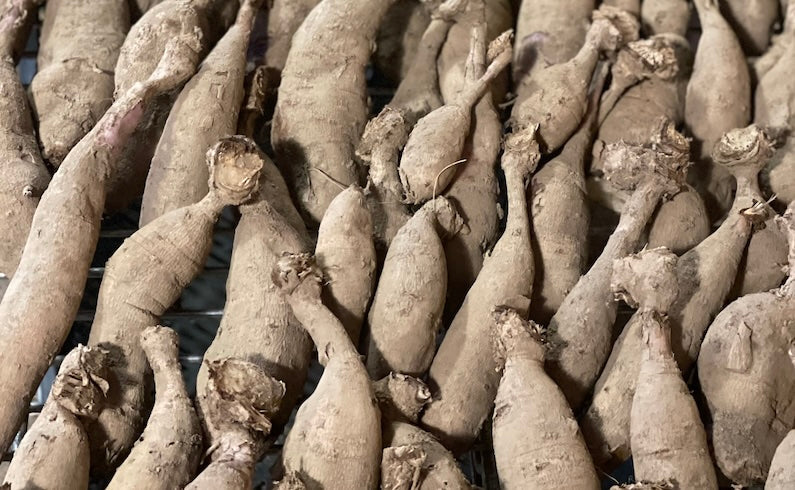For decades, dahlia growers have followed a long-standing gardening tradition: leave tubers in the ground until the first hard frost. It’s a deeply ingrained practice, but not entirely based on science. And like most garden wisdom passed through generations, there’s some truth buried in the frost-bitten foliage, but we are learning more every day.
But what really determines when a dahlia tuber is ready to be dug? Is it temperature? Day length? Time? The answer is: all three—but not in the way you might think.
Day Length: The Hidden Tuber Signal
Dahlias are short-day plants, meaning they respond to the waning daylight of late summer and early fall. As the days shorten past 12 hours, dahlias instinctively begin shifting energy away from flower production and into tuber development. This is nature’s cue that the season is ending, even if temperatures are still mild. By the time day length drops to around 11 hours (mid-fall in many regions), tubers are actively hardening and storing carbohydrates, preparing for dormancy.
In other words, tubers don’t wait for frost to begin maturing—shorter days trigger the process well in advance.
Optimal Day Length for Flowering and Tuber Formation
Flower Development: Though dahlias can form buds when day length is at 11 hours, they will flower more consistently when day length falls between 14–12 hours, typically in mid-to-late summer depending on location.
Tuber Formation: While dahlias can continue flowering under shorter days, tuber development is most active when day length falls below 12 hours. By the time it reaches 11 hours, the plant focuses almost entirely on storing carbohydrates in the tubers.
This means that while dahlias begin flowering well before their tubers mature, the same decreasing daylight that triggers blooms also sets the stage for tuber hardening later in the season.
Temperature: The Final Push
While day length sets the process in motion, temperature influences its speed and efficiency. Cooler nights (consistently below 45°F) further encourage tuber dormancy, helping to toughen their skins and concentrate stored energy. But a sudden hard frost doesn’t magically “finish” the tuber. Instead, it simply kills off the plant’s top growth, signaling that the season is over.
In colder climates, frost is a handy way to mark the transition, but in milder zones where dahlias can keep growing well into fall, waiting for a freeze can actually mean delaying too long. A better approach is watching for reduced flower production, and yellowing foliage - signs that tubers are naturally finishing their cycle.
Time: The Unsung Variable
If you planted late, your tubers may not have had enough time to fully mature before frost arrives. In general, dahlias need 120–140 days from planting to produce fully developed, storage-ready tubers. If your season is cut short by an early freeze, lifting them prematurely might mean less development, but size is not a defining factor of viability.
What About Growers in Cold Climates?
For growers with short seasons, does this mean they will never have good tubers? Not necessarily. While a full 120–140 day growing window is ideal, there are ways to maximize tuber development in colder climates:
Choose Early Blooming Varieties: Some dahlias naturally mature faster than others, such as 'Totally Tangerine' 'Linda's Baby,' 'Creme de Cognac', 'Ryecroft Jan' and 'Strawberry Cream' making them better suited for short seasons.
Use Season Extension Techniques: Row covers or low tunnels can help warm the soil and extend the season by a few crucial weeks.
So When Should You Dig?
Forget the frost myth—think of it as a convenient landmark, not a scientific necessity. Instead, use a combination of science and natural signs:
- Day Length - If days are under 11 hours, tubers are well on their way to maturity.
- Temperature - If nights are consistently below 45°F, dormancy is setting in.
- Plant Signs - Yellowing leaves, woody stems, and slowed flower production mean tubers are ready.
- Skin Toughness - If a tuber’s skin rubs off easily, it’s still immature. If it’s firm, it’s ready.
The Verdict: Science Over Tradition
So, while the first hard frost is an easy reference point, it’s not the magic moment of tuber readiness. We now have an approach rooted in observation rather than habit. In reality, day length triggers the process, temperature fine-tunes it, and time ensures completion.
Armed with this information, gardeners in colder zones can dig their tubers before frost without being rushed by freezing temperatures or forced to work in harsh conditions. Likewise, in temperate zones, growers no longer need to wait anxiously for a frost that may never come. This knowledge offers freedom using natural signals to make the best decision for each region and growing situation. By reading the plant rather than the thermometer, you can harvest fully matured, storage-ready tubers without playing a game of freeze tag with the weather.





Fantastic post!!! Thank you
We started harvesting mid October starting w the ones that what in first .🌸
Really great concise info. Thank so much for this simple set of rules. God’s creation is a blessing.
I have had my dahlias return in my zone 6 garden. We have had rather mild winters here in Michigan. Not sure about next season, because this winter is showing us that we can still have real Michigan winters. I did heavily mulch them with shredded leaf mulch. Keeping my fingers crossed, maybe the dahlia gods will bless me again!
Here on the Oregon coast mine don’t seem to have eyes visable when I dig in the fall. I’m experimenting with digging very early spring this year..
Very helpful, thank you!